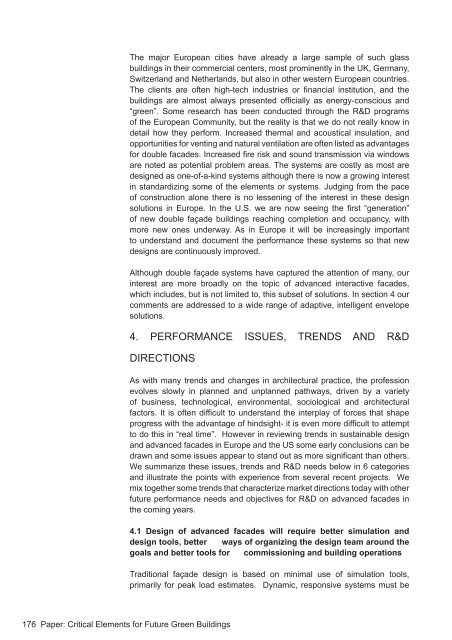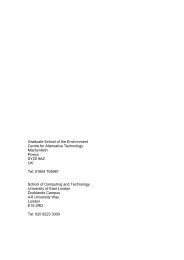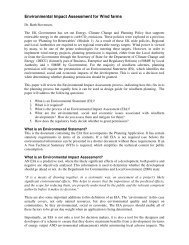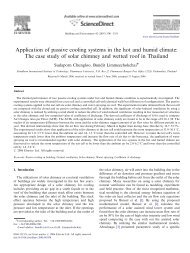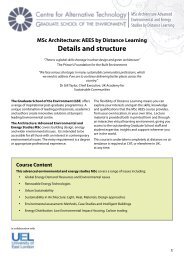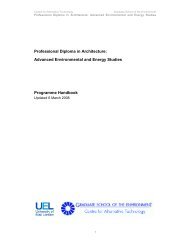Module B1 Study Book - the Graduate School of the Environment
Module B1 Study Book - the Graduate School of the Environment
Module B1 Study Book - the Graduate School of the Environment
Create successful ePaper yourself
Turn your PDF publications into a flip-book with our unique Google optimized e-Paper software.
The major European cities have already a large sample <strong>of</strong> such glass<br />
buildings in <strong>the</strong>ir commercial centers, most prominently in <strong>the</strong> UK, Germany,<br />
Switzerland and Ne<strong>the</strong>rlands, but also in o<strong>the</strong>r western European countries.<br />
The clients are <strong>of</strong>ten high-tech industries or financial institution, and <strong>the</strong><br />
buildings are almost always presented <strong>of</strong>ficially as energy-conscious and<br />
“green”. Some research has been conducted through <strong>the</strong> R&D programs<br />
<strong>of</strong> <strong>the</strong> European Community, but <strong>the</strong> reality is that we do not really know in<br />
detail how <strong>the</strong>y perform. Increased <strong>the</strong>rmal and acoustical insulation, and<br />
opportunities for venting and natural ventilation are <strong>of</strong>ten listed as advantages<br />
for double facades. Increased fire risk and sound transmission via windows<br />
are noted as potential problem areas. The systems are costly as most are<br />
designed as one-<strong>of</strong>-a-kind systems although <strong>the</strong>re is now a growing interest<br />
in standardizing some <strong>of</strong> <strong>the</strong> elements or systems. Judging from <strong>the</strong> pace<br />
<strong>of</strong> construction alone <strong>the</strong>re is no lessening <strong>of</strong> <strong>the</strong> interest in <strong>the</strong>se design<br />
solutions in Europe. In <strong>the</strong> U.S. we are now seeing <strong>the</strong> first “generation”<br />
<strong>of</strong> new double façade buildings reaching completion and occupancy, with<br />
more new ones underway. As in Europe it will be increasingly important<br />
to understand and document <strong>the</strong> performance <strong>the</strong>se systems so that new<br />
designs are continuously improved.<br />
Although double façade systems have captured <strong>the</strong> attention <strong>of</strong> many, our<br />
interest are more broadly on <strong>the</strong> topic <strong>of</strong> advanced interactive facades,<br />
which includes, but is not limited to, this subset <strong>of</strong> solutions. In section 4 our<br />
comments are addressed to a wide range <strong>of</strong> adaptive, intelligent envelope<br />
solutions.<br />
4. PERFORMANCE ISSUES, TRENDS AND R&D<br />
DIRECTIONS<br />
As with many trends and changes in architectural practice, <strong>the</strong> pr<strong>of</strong>ession<br />
evolves slowly in planned and unplanned pathways, driven by a variety<br />
<strong>of</strong> business, technological, environmental, sociological and architectural<br />
factors. It is <strong>of</strong>ten difficult to understand <strong>the</strong> interplay <strong>of</strong> forces that shape<br />
progress with <strong>the</strong> advantage <strong>of</strong> hindsight- it is even more difficult to attempt<br />
to do this in “real time”. However in reviewing trends in sustainable design<br />
and advanced facades in Europe and <strong>the</strong> US some early conclusions can be<br />
drawn and some issues appear to stand out as more significant than o<strong>the</strong>rs.<br />
We summarize <strong>the</strong>se issues, trends and R&D needs below in 6 categories<br />
and illustrate <strong>the</strong> points with experience from several recent projects. We<br />
mix toge<strong>the</strong>r some trends that characterize market directions today with o<strong>the</strong>r<br />
future performance needs and objectives for R&D on advanced facades in<br />
<strong>the</strong> coming years.<br />
4.1 Design <strong>of</strong> advanced facades will require better simulation and<br />
design tools, better ways <strong>of</strong> organizing <strong>the</strong> design team around <strong>the</strong><br />
goals and better tools for commissioning and building operations<br />
Traditional façade design is based on minimal use <strong>of</strong> simulation tools,<br />
primarily for peak load estimates. Dynamic, responsive systems must be<br />
176 Paper: Critical Elements for Future Green Buildings


